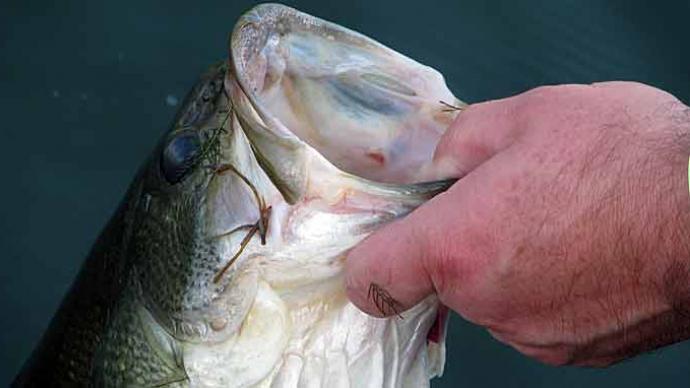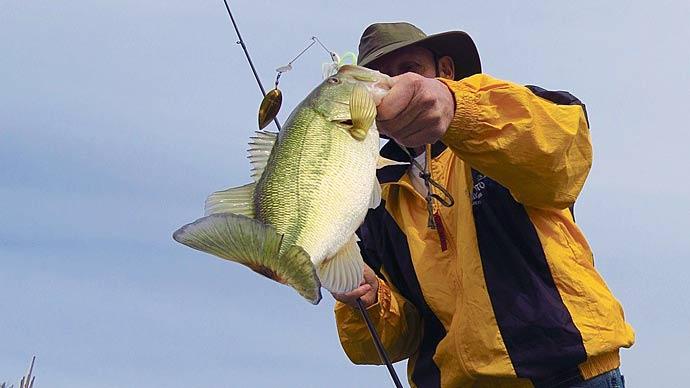
The most challenging part of catching fish is the important first step of finding where they are in a given body of water. Since bass are often likely to run in packs or schools, you will often find several where you find one.
Schooling bass can be thought of in two categories. The first are those that help you figure out where they are by breaking the water's surface during warmer months. The second group includes schools that seldom break the water's surface, even in the summer months.
Bass that hold in schools of either type during any time of the year can be counted on to do a couple of things. First, they'll be in a particular area because there is a concentration of prey and, when not feeding, will hold close to structure or depth changes. The most likely holding locations are where both criteria are met.
Schools will tend to stay relatively shallow in the part of the lake where the water is stained. If the school is in clearer water, they tend to hold at deeper levels when not actively feeding. They'll also hold in deeper water during cold weather periods.
One parameter determines the maximum depth at which bass do not concentrate, even in clear water during the summer. This is the thermocline layer where there is an appreciable temperature change. The oxygen line, where oxygen is deficient in the water, will not hold bass, either. Bass can tolerate temperature change but cannot survive without oxygen. Neither can the forage fish. Knowing this will help you to locate the comfort zone on a lake during the summer by finding where schools of shad are located.
Words of caution here, don't think that schools of bass are constantly feeding on shad. In late fall and early winter, schools may be focusing their total attention on bream. As a result, bream tend to drop back into the bottom to the closest channel as each cold front passes.
I have caught schooling bass concentrated in five feet of stained water at Lake Somerville and in over 60 feet of water in Toledo Bend during the summer. While schooling bass are sometimes very willing to hit various plugs, they can also be quite selective. Few things are more frustrating than seeing fish and being unable to catch them.
Your range of choice for lures will be everything from topwaters to bottom-bumpers. So, let's take a look at the options and use of each one.
Bass that are breaking the surface are usually vulnerable to topwater presentations. The question is, which topwater? Smaller schoolies are usually foraging on smaller shad, so you must match the lure to the size of the food. If the fish won't hit a larger bait, downsize. A Zara Spook may be your choice for a three-pound or larger fish, but schools of two-pounders may only want a Tiny Torpedo. In clear lakes, you'll need a clear version of this bait.
Noisy topwaters may be useful for some breaking fish, but others may want more subtle presentation baits like a Slug-Go or other jerkbait. If the fish are coming up in brush, the weedless presentation of a soft, plastic jerkbait doesn't hurt your chances.
My favorite plug for working breaking fish is a buzzbait. For some reason, these lures drive bass nuts. They also seem to force strikes from fish that might be less interested in a larger topwater plug. Even here, though, you might want to use smaller-bladed baits. Choosing white or silver in any school bait is logical since you usually try to mimic shad.
Topwaters and other "throw-and-crank" plugs should be of sufficient weight to permit casts of considerable distance. To catch breaking bass, you must hit the area while they are up.
Baits that work for sub-surface and deeper schooling fish include a range of diving crankbaits and the standbys, lipless cranks. A chrome Super Spot or Rat-L-Trap is a necessity for working schooling bass.
Interestingly, I don't see many people relying on spinnerbaits as part of their school bass arsenal. However, these are great baits for catching schooling bass and should be used with sub-surface or countdown retrieves. Learn how long it takes for your favorite spinnerbaits to fall and plan your retrieve rate to permit working a given strata of schooling areas.
Depth is necessary because larger fish in schools are often below the more active fish. We tend to think this is because they are older, wiser, and pick up wounded prey that the masses above them knock down. Another given is that larger bass track schools of smaller bass and feed on their unsuspecting members concentrating on shad. This larger, bass-colored bait should also be tried, mainly if the schools appear to be made up of smaller fish.
You are lucky if the bass go down and hold in fishable areas before surfacing again. In these locations, you'll need to work a soft plastic bait or spoon or tail spinner, such as a Little George.
When schools are suspended above a significant change in temperature or oxygen content, you cannot allow your fast-falling bait to go through the layer of fish. Therefore, a countdown technique is necessary when fishing suspended schools, and a swimming technique must be used to keep the bait at the right level. You'd do just as well to keep them in the boat as fish them in dead water zones.
Bass that localize in holding areas after breaking or schools that stay near the bottom in a small area are vulnerable to worms, lizards, and Carolina-rigged French fries. The size of the soft plastic is essential. The shorter French fry is an excellent producer of fish.
Try vertical presentations to get directly over the schools without disturbing them. This can be done more easily in colder or warmer months with deeper-holding fish. A good depth finder is vital in this type of presentation because you will concentrate on areas where you find suspended schools of shad. There is always a tendency to work spoons, Little Georges, and such, but jigs will also work well. One of the better colors has been a solid white jig with an oversized white frog as a trailer.
Deeper schools of fish in very cold or warm months will most likely suspend at a given depth. Thus, the refinement of a jigging technique used to catch fish is to count the bait down to a desired depth and slowly swim it back to the boat. The same technique can be worked successfully if you have the patience to let a jerkbait sink to the desired level.
One of the most reliable features of schooling bass is that they feed close to the same time and area for several days or weeks. The significant advantage to working these schools is they are likely to stay in the area unless they are forced to move due to a shift in forage, temperature change, or water level change. In other words, your best chance for the most reproducible fishing is when you have uncovered the riddles associated with schooling bass.
Many people believe that schooling bass are only small fish. This is sometimes true, but bass tend to run in groups of the same size and age. Thus, somewhere in the lake are schools of larger bass. They are usually in deeper holding areas than most people are fishing. In addition, fewer fish reach older ages (larger sizes), so schools of larger fish generally contain fewer fish than schools of smaller bass.
School bass can be fished in many ways, and sometimes it's easy to work out the lessons taught by the schools. But, then, there will be times you may have to try several problem-solving techniques to pass the course.




